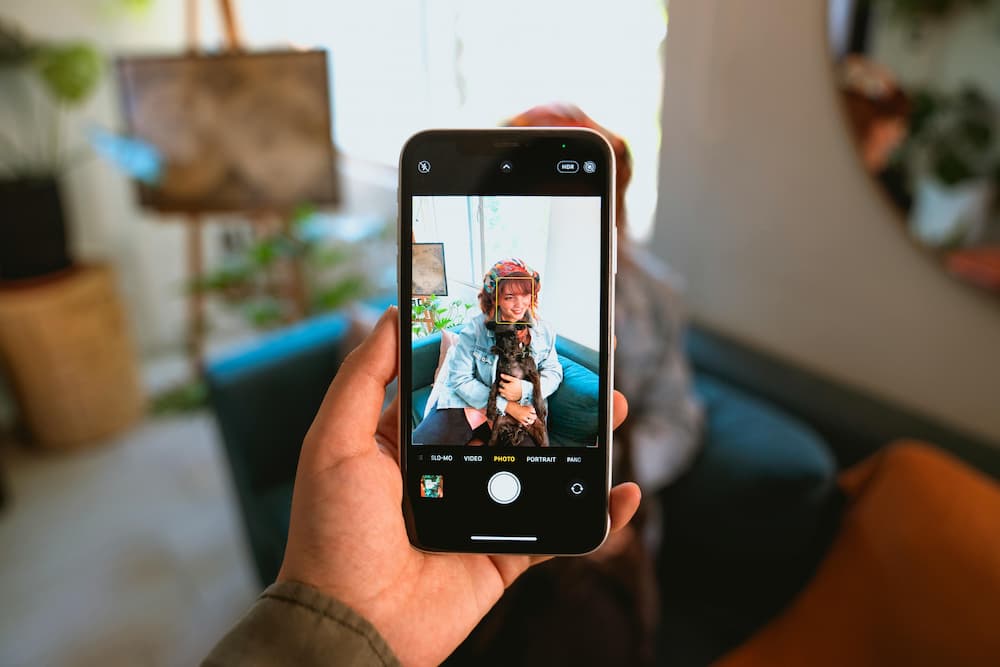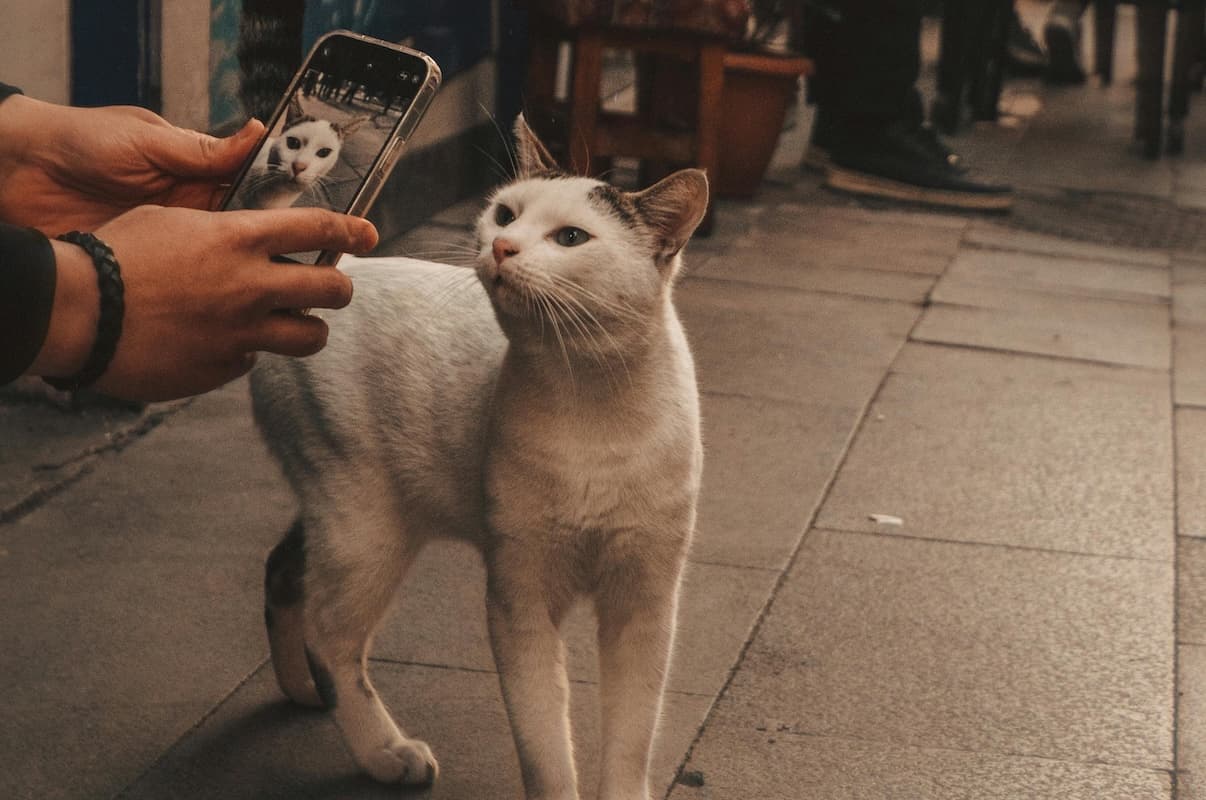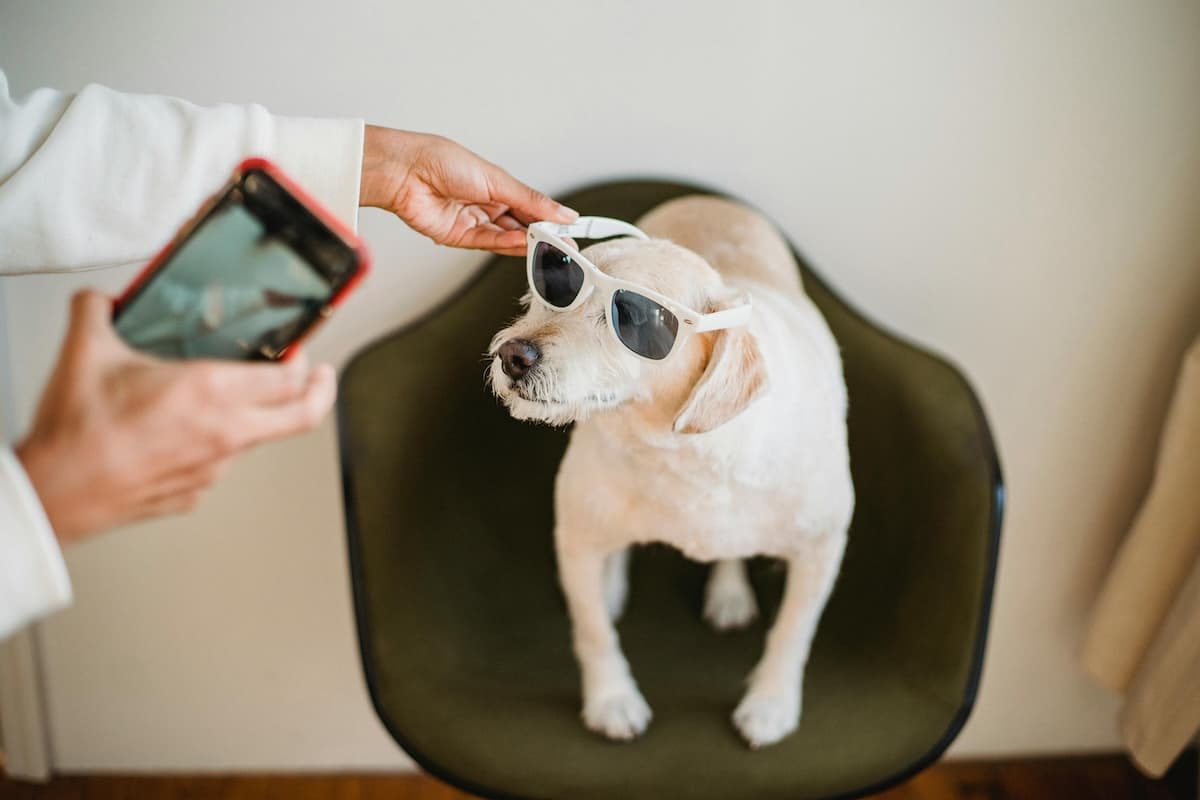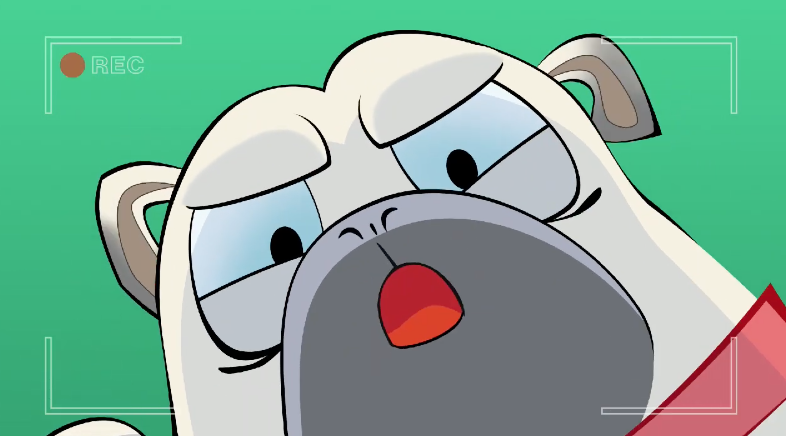

14 Tips for Taking Picture Perfect Pet Photos
Tips for taking the perfect picture of your pet – tips for taking the perfect pet photo – how to make them stay still, how to direct them and capture the perfect moment – either alone or with the owner.

Writer Jannah Berkley
12 min read

Now that everyone has a professional-grade camera in their pockets, taking photos has never been easier. But taking photos that are actually good, especially when the subjects are creatures who won’t stay still for a nanosecond? That’s a different story altogether- and precisely what this article’s for.
Whether you’re more puppy paparazzi or covert cat cam, your phone’s camera roll is probably made up of 50% pet photos (if not more). With a fur baby who’s that silly, cuddly, and random, it just makes sense. But taking a million photos doesn’t guarantee you’re going to capture your pet’s je ne sais paw.
Being inspired by your subject is step one of any great photograph. But how do you make them stay still? How can you capture the right moment? How can you really show off who they are? Here are some pro tips on how to get phenomenal photos of your pet every time.
1. Lighting
Natural light brings out the beauty and the authentic personality in everyone, including your pets.
When indoors, try to capture your pet near a window or door. Your back should be to the wall and they should be facing the light for the best shot. Overhead lighting always comes off harsh and creates unflattering shadows. If you need more light, use lamps to diffuse the light while brightening up the surroundings.
When outdoors, timing is everything. Early morning and late afternoon are best. Golden hours (also known as magic hours) come twice a day, one hour after sunrise and one hour before sunset. This light is super soft and beautifying at these times of day. This is because the sunlight hits your furry friend at an angle that diffuses the light and casts a longer shadow. When shooting outside, pay attention to any harsh shadows cast by nearby trees or buildings. It’s better to capture your pet fully in shadow or fully in light. When mixed, the magic of the moment gets lost in the battle of the light.
Don’t use flash! Not only will it create an unnatural glow and red-eye, but it can seriously stress out your pet.
2. Fast shutter speed
First of all, what exactly is shutter speed? The shutter speed means how fast the camera’s shutter opens and closes when you take a picture. Animals are unpredictable and move quickly, which is why you need your camera to be motion-ready. If the shutter speed is too low, you’ll capture a blurry ghost instead of that once-in-a-lifetime trick.
On your smartphone, you more than likely have a continuous shooting mode (A.K.A. action or burst mode). This will capture a series of very quick photos in one long click, allowing you to select the exact perfect moment.
On a camera, the speed depends on your lens and the lens magnification. Technically, 1/200s (shutter open for one two-hundredth of a second) is good for normal movement and 1/1000s (shutter open for one-thousandth of a second) or higher for when your pet is running or jumping.
3. Location, location, location
Even the most pawfect moment can be ruined by a distracting background. So choose your location wisely! Often, the best photos happen when you follow (A.K.A. stalk) your pet. When you try to make them pose, or come to you, their bodies are stiff and unnatural. If you go where they want to go, though, you’ll actually be able to capture them in their natural mode.
Photoshoots on a set or in an unnatural setting are a real challenge for the average pet. Unless they’re some sort of pet influencer and are very used to bright lights, paper backgrounds, and strange smells, chances are they won’t respond well to these spaces.
A simple background is always best if you want your pet to star. If you’re shooting indoors, move your laptop, unplug unnecessary things from the wall and take your coffee off the counter. Alternatively, find a simple wall or corner that’s already uncluttered.
Outside, look out for background “noise” like people, other pets, garbage cans, light posts, holes, and random sticks. Unless your pet is directly interacting with an object, random objects can clutter the frame.

4. Camera selection
If you’re a professional photographer, you know best. But for those of us who are just taking photos for fun, there are some simple options.
First of all, smartphones have significantly upped their camera game in the last few years. It does matter which camera mode you choose, though. Most phones have a wide-angle lens as the automatic choice. Portrait mode creates a depth of field effect, automatically making your pet the focal point and the background slightly blurred. Panoramic mode can capture your pet and the epic landscape at the same time. Macro mode (with good lighting) can show off that wet snout, little paws and the tiny details you love most.
In terms of real cameras, a DSLR will allow you total control over a shot. You have many settings and lens types that phones don’t have. For portraits, a bigger and heavier camera might work. But for action shots outside and in nature, it’s important to have a light, easy to snap camera. Exactly which camera should you choose if you don’t already have one? There are many photography experts who compare and recommend the best cameras for pet photography. You can look them up after you finish reading our guide.
5. Perspective and angles
There are some basic composition rules that can help you get a great photo even if you haven’t ever studied photography.
- The rule of thirds: Imagine your image is broken up into 9 equal rectangles. The rule of thirds would suggest placing your pet to the side of the image, leaving the other two thirds of the image more open.
- Leading lines: These are lines in a photo that direct the eye to the main event. Leading lines can be horizontal, vertical, diagonal, converging or curved. But no matter what formation, they lead the viewer’s eye to the star of the shot: your pet.
- Eye level: Bringing your body to the floor or to your pet’s eye level will make a photo much more engaging. It makes it feel like you’re now looking through their eyes, from their vantage point.
- Wide angle: This can create a cinematic scene for your pet in their environment. Use the ultra-wide setting on your phone to create that expansive feeling of your pet in space.
6. Eyes in focus
Have you ever been awestruck and had to stop and look closer at an image? Often this is because the subject is looking directly at you, in total focus. Your pet’s eyes tell a whole story, and catching those sharp eyes are the key to evoking emotion.
Make sure the eyes are in focus by using the touch screen focus feature on your smartphone or single point autofocus on your camera. Some DSLRs have eye AF (eye-detection autofocus) for animals. If your camera has this, definitely try it out!
If you’re very close to your pet and have a shallow depth of field, you might only be able to get one eye in focus. Make sure it’s the eye that’s closest to the camera to get that feeling of them looking directly through the image and into your soul.

7. Editing
Brushed fur? Great. Airbrushed fur? Not so much. A real photo of your beloved pet can start to look like an AI invention if you get too into photoshopping their fur, fluff or face. For a natural-looking shot, editing should be used to enhance the photo, not make major changes.
Using editing software or apps to remove distracting details is great. For example, you can cover up tags or brand names on their leash/collar, remove random leaves or holes on the ground in front, or mask a tree or object in the background sticking up behind their head.
Some tools that always enhance pet photos include unblur, red-eye removal, and adjusting brightness, contrast, and sharpness.
Most of the time, getting the perfect composition in a click is impossible. But a crop can completely transform a picture. Play with crop to see if the moment is more powerful in the center, off to the side or super zoomed in.
8. Make it macro
It’s easier to take a photo of your pet and everything surrounding them. But close-ups are an amazing choice to show off their personality. In order to do this, you always need good lighting. Then you can use portrait mode on your phone or a zoom lens to get really close. The details, like their eyes, paws, ears, and tails, can say so much when you focus on them.
Your camera or phone might even have a built-in macro mode. This allows you to focus on the wetness of their nose or the shiny whiskers while blurring the background. Sometimes all you need to do is really zoom in to get that shot!
9. Surprise
In order to even be ready for a photo, the setup for your phone or camera can take a few seconds- or minutes. Let your pet be, continue playing, resting or whatever they’re doing. Don’t let them see you while you do your setup. As soon as they sense a camera, they react. They’re very sensitive to that energy, even more so than a lot of us!
Once your camera is ready, do something that gets their attention quickly. You can whistle, call their name or make a weird sound. The moment they look up at you is THE moment to capture. They will be full of energy and their expression will be attentive. If you need more ideas of how to get their attention, nab some sound effects from @thedogist’s videos (you guessed it- after you finish the article).
10. Timing
Follow your pet’s natural routine so that you can maximize the window for getting that perfect shot. They’ll be sleepy and slow right before their naptime or right after they wake up. This is a great time to get macro shots, close-ups of their face, or cozy shots of them indoors.
Do they get the zoomies every day around the same time? Or maybe there’s that moment when they scratch at the door to explore? This will be peak energy. You can get some amazing action shots when they’re naturally in that mode anyway.

11. Patience
Even though your pet can totally read your energy when you need a cuddle or a paw hold, they’re not so patient when you have a camera in hand. So you need to be patient with them instead. Following their routine will help you actually capture the photo you’re dreaming of. Just because you got your phone out or set your camera up any time of day won’t mean they’ll play along. When they’re very calm or busy with their favorite activity, that’s the moment!
12. Treats and toys
In many ways, getting your pet to be the subject of a photo is like any other trick. And tricks require treats! Hold a treat above your phone or camera to get and keep your pet’s attention for the photo.
This also works with toys. You can shake their favorite toy above the camera to get them to look directly at you. And then you can get some amazing action shots once you hand it or throw it to them.
Toys in the shot also say a lot about your pet’s personality or the spirit of the photo. A turkey chew toy says cozy fall, a purple cat scratcher castle says royalty. Choose the right toy for the theme you’re trying to capture as well as your pet’s natural joy.
13. Selfies
That wide-angle on your phone was made for this. It expands the view way beyond your natural arm’s reach.
Some phone cases can have a treat-holder extension added. This way you can clip a treat to the top of the phone and keep your dog’s interest while freeing up both hands.
Using a phone tripod or selfie stick can also free up your hands to help get your pet in the right position. You can play with your pet as you take the photos easier with the built-in balance.
14. Unique character
A lot of pet photography can start to look the same. But what makes for those truly special photos is highlighting the qualities that only your pet has. Does your pet have two different eye colors, one very floppy ear, an atypical fur pattern, a favorite toy or a certain food obsession? Maybe they love to make their humans laugh, they welcome you home by licking your feet, they must sniff every shoe that comes through the door. These are the moments to try and capture!
Shamelessly taking photos of your pet all the time is a right of passage as a dog or cat parent. But in order to keep your meowing muse or pup-fluencer smizing for the camera, you need to make sure they stay healthy and happy. Animalia’s dog and cat insurance can help you cover expenses related to accidents, injuries, and illnesses. If you have Animalia, you’re not worrying so much about all the costs of taking care of your pet, and can focus on capturing those magic moments on film.





We offer the most
comprehensive coverage
out there
car with a spare tire for life’s bumps.
Having Animalia is like a pimped-out
Rolls Royce with a swimming pool
in the trunk.



Get your pet insurance quote
Pet type
- Dog
- Cat
What is your pet's name?
Zip code





